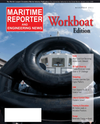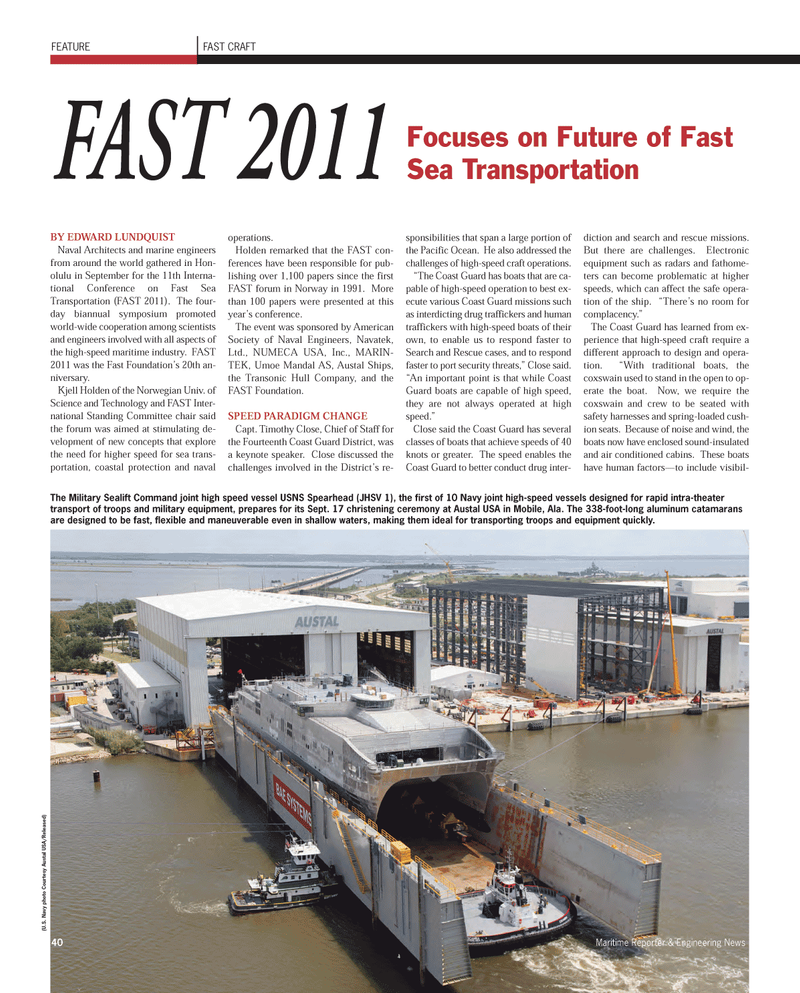
Page 40: of Maritime Reporter Magazine (November 2011)
Feature: Workboat Annual
Read this page in Pdf, Flash or Html5 edition of November 2011 Maritime Reporter Magazine
FEATURE FAST CRAFT 40Maritime Reporter & Engineering News FAST 2011 Focuses on Future of Fast Sea Transportation BY EDWARD LUNDQUIST Naval Architects and marine engineers from around the world gathered in Hon- olulu in September for the 11th Interna- tional Conference on Fast Sea Transportation (FAST 2011). The four- day biannual symposium promotedworld-wide cooperation among scientists and engineers involved with all aspects of the high-speed maritime industry. FAST 2011 was the Fast Foundation?s 20th an- niversary. Kjell Holden of the Norwegian Univ. of Science and Technology and FAST Inter- national Standing Committee chair saidthe forum was aimed at stimulating de- velopment of new concepts that explore the need for higher speed for sea trans-portation, coastal protection and naval operations. Holden remarked that the FAST con- ferences have been responsible for pub- lishing over 1,100 papers since the first FAST forum in Norway in 1991. More than 100 papers were presented at thisyear?s conference. The event was sponsored by American Society of Naval Engineers, Navatek, Ltd., NUMECA USA, Inc., MARIN-TEK, Umoe Mandal AS, Austal Ships, the Transonic Hull Company, and the FAST Foundation. SPEED PARADIGM CHANGE Capt. Timothy Close, Chief of Staff for the Fourteenth Coast Guard District, was a keynote speaker. Close discussed the challenges involved in the District?s re- sponsibilities that span a large portion of the Pacific Ocean. He also addressed the challenges of high-speed craft operations.?The Coast Guard has boats that are ca-pable of high-speed operation to best ex- ecute various Coast Guard missions such as interdicting drug traffickers and human traffickers with high-speed boats of their own, to enable us to respond faster to Search and Rescue cases, and to respondfaster to port security threats,? Close said. ?An important point is that while Coast Guard boats are capable of high speed,they are not always operated at high speed.? Close said the Coast Guard has several classes of boats that achieve speeds of 40 knots or greater. The speed enables the Coast Guard to better conduct drug inter- diction and search and rescue missions.But there are challenges. Electronicequipment such as radars and fathome- ters can become problematic at higherspeeds, which can affect the safe opera- tion of the ship. ?There?s no room for complacency.? The Coast Guard has learned from ex- perience that high-speed craft require adifferent approach to design and opera- tion. ?With traditional boats, the coxswain used to stand in the open to op- erate the boat. Now, we require the coxswain and crew to be seated with safety harnesses and spring-loaded cush-ion seats. Because of noise and wind, theboats now have enclosed sound-insulated and air conditioned cabins. These boats have human factors?to include visibil- The Military Sealift Command joint high speed vessel USNS Spearhead (JHSV 1), the first of 10 Navy joint high-speed vessels designed for rapid intra-theatertransport of troops and military equipment, prepares for its Sept. 17 christening ceremony at Austal USA in Mobile, Ala. The 338-foot-long aluminum catamarans are designed to be fast, flexible and maneuverable even in shallow waters, making them ideal for transporting troops and equipment quickly. (U.S. Navy photo Courtesy Austal USA/Released) MR Nov.11 # 5 (34-41):MR Template 11/7/2011 9:22 AM Page 40

 39
39

 41
41
